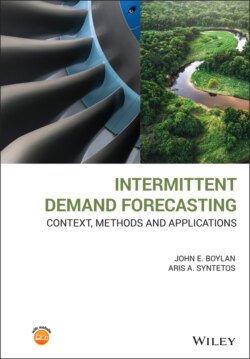Читать книгу Intermittent Demand Forecasting - John E. Boylan - Страница 27
1.4.2 Business Context
ОглавлениеWith robustness in mind, this book presents a range of approaches to intermittent demand forecasting that are applicable in any industrial make to stock (MTS) setting. In addition to an MTS setting, unless otherwise specified, we focus on single stock keeping unit (SKU), single stocking location environments, as explained below.
Make to stock. In an MTS environment, customers are willing to wait no more than the time it takes to deliver the particular item to them and so the item needs to be available in stock, ready to be dispatched, or, in the case of retailing, it needs to be available on the shelf. In this case, demand is not known and needs to be predicted. The alternative environment is known as make to order (MTO), where the products are not assumed to be in stock, and the customer must wait until the manufacturer assembles the product for them. In this case, customer demand is known and does not need to be predicted. This situation is common for some products (e.g. furniture) but not for others (e.g. automotive or aerospace spare parts). There is also a move to 3D printing of products in some industries, which is a form of MTO but with shorter delays (Technical Note 1.1).
Single stock keeping unit (SKU) approaches. We are looking at forecasting the requirements (and managing the inventories) of single SKUs. Although some of the methods to be discussed in this book rely upon collective considerations (across a group of SKUs), the rest of the material considers single SKU problems. This is because higher levels of aggregation are, typically, not associated with intermittent demand. Consider, for example, 10 intermittent demand items, all of which are replenished from the same supplier. It makes sense to consider the aggregate demand of those items to facilitate efficient transportation arrangements. However, although demand at the individual SKU level may be intermittent, aggregate demand (across all 10 SKUs), most probably, will not be intermittent.
Single stocking location approaches. We focus on determining inventory replenishment requirements at each single location, without taking into account interactions between locations. As such, we do not consider the possibility of satisfying demand by lateral transshipments of stocks between stores. This is because these decisions relate explicitly to joint inventory‐transportation optimisation, which is beyond the scope of this book. Further, and as discussed above, aggregate demand (across different locations in this case) is typically not associated with intermittence.
We should also mention that, although the term ‘demand’ is being used in this book when referring to forecasting, demand will not always be known and, in this case, actual sales must be used as a proxy. The terms ‘demand’ and ‘sales’ are used interchangeably in this book although, strictly speaking, the latter is often used as an approximation for the former.
